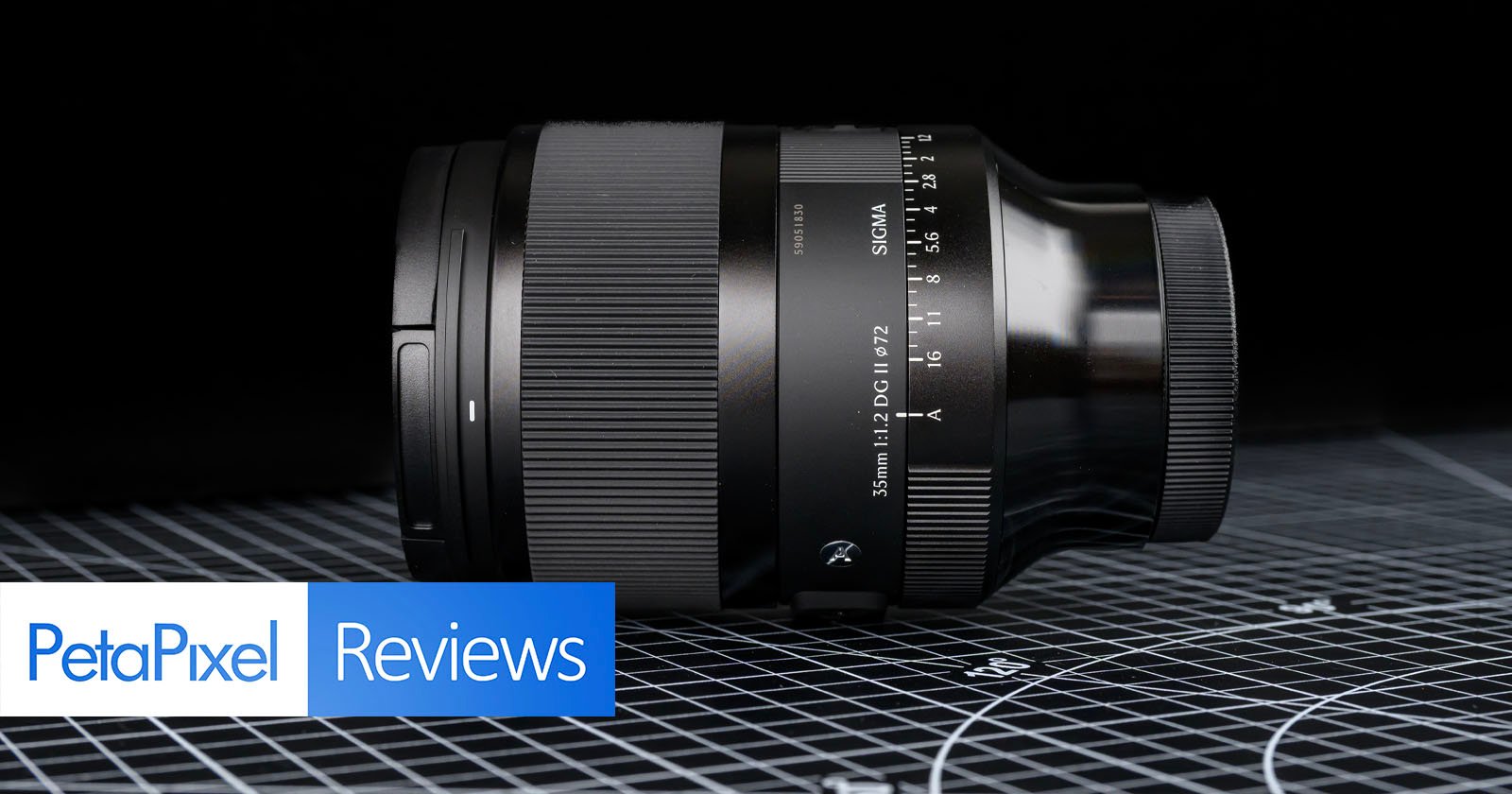
35mm has long been one of my favorite focal lengths, so it’s odd that I never had the chance to use the original Sigma 35mm f/1.2 DG Art as it would be right in my wheelhouse. Fortunately, when Sigma launched the second version of this optic in both E-Mount and L-Mount, I had a chance to make up for this omission.
The Sigma 35mm f/1.2 DG Art II boasts a reduced size and weight while including all the latest professional features, so I set out on the streets of Calgary to see how it would do.
Sigma 35mm f/1.2 DG Art II Review: How It Feels
The first thing you notice about this lens is the weight. Reduced from 910g down to 745g, the latest version feels downright petite compared to the other 35mm f/1.2 lenses I’ve tested from Nikon and Viltrox. It didn’t feel unbalanced on the small Sony a7R V I used without an attached grip.
Despite that, this lens still maintains the excellent build quality I expect from an Art series lens. The focus ring is well-damped, an aperture ring is present, the mount is weather-sealed, and the included hood is well-made with a clicking lock.
In terms of controls, there is a manual focus selector switch, a custom button, a toggle switch for having smooth motion or click stops on the aperture ring, and a switch to lock the aperture into auto mode. The filter diameter is a very common 72mm diameter, a nice change from the more expensive 82mm filters that its precursor required. It’s truly full-featured and feels like a premium optic in the hand.
Sigma 35mm f/1.2 DG Art II Review: How It Shoots
Unlike the original version, this lens now sports Sigma’s latest linear motor, which allows the lens to jump almost instantly from minimum focus to infinity. While I doubt this lens will often be used for sports or wildlife work, the f/1.2 aperture requires incredible precision to consistently hit focus, something this new motor delivers.
Longitudinal chromatic aberrations, or LoCA, are often present in very fast aperture primes. This is where a color shift can be seen between the background and foreground areas. It’s quite distracting and, unfortunately, quite difficult to remove in editing. While not terrible, I did find that these color shifts could occur on this lens when shooting wide open. If you have a lot of high-contrast foreground and background elements, it’s worth stopping the lens down to even f/1.8 to minimize this effect.
When shooting at bright light sources, some minor flare can be observed. While the image retains contrast very well in these situations, there are some issues with ghosting. You will find small blobs of light that are slightly visible at f/1.2 and become more defined upon stopping down. Overall, flare will rarely be an issue, but it’s worth checking to make sure ghosting is not impacting any important parts of your composition.
One reason many photographers will be looking at this lens is for the shallow depth of field it makes possible. Because of that, the appearance of the bokeh, or out-of-focus areas, is very important. The Sigma 35mm f/1.2 DG Art II boasts lovely bokeh, with extremely smooth transitions from the in-focus to out-of-focus areas. Specular highlights are smooth, with no soap bubble effect and minimal onion rings. The only possible complaint is that cat’s eye or oval specular highlights will be visible toward the edges of the frame until the lens has been stopped down significantly to even f/2.8. But cats-eye does not bother me, so I loved the look I could achieve shooting subjects close, wide open.
As I am frequently shooting video, I wanted to see how the breathing performance was on this lens. Breathing is where the field of view shifts depending on your focus distance. Substantial breathing can be very distracting when pulling focus while recording video. Fortunately, while there is a slight change in the field of view when shifting focus dramatically, it is very well controlled and would rarely be noticed in a conventional focus pull. This, along with the small size and fast focus, makes this lens a great choice for videographers and cinematographers.
While I had never used the original Sigma 35mm f/1.2 DG Art, I was aware of its reputation for requiring a bit of stopping down for maximum sharpness and contrast. Upon looking at our test charts, I was extremely impressed with central performance.
The middle of the frame is extremely sharp and contrasty even at f/1.2. Stopping down to f/2.8 marginally improves contrast, but it is certainly not required. Looking at extreme corners, there is some softness wide open, but by f/2.8, the frame is sharp from center to corner.
This is particularly impressive as the a7R V’s 60MP sensor is extremely demanding, and the lens could easily deliver results to make the best of that resolution.
Sigma 35mm f/1.2 DG Art II Review: Great Images From A Small Package
A 35mm f/1,2 is not the kind of lens I’d typically think of bringing with me all day, but this new lens from Sigma makes a compelling case for doing just that. I love the look of a moderate wide-angle with shallow depth of field, and the Sigma can truly deliver some unique images. The improvements to the AF performance mean you will be rewarded with more keepers, especially for candid portraits, and the lens feels like a luxury optic. While size and weight are not a major concern with this lens, price might be.
Coming in at $1,550, it is more affordable than Nikon’s offering but considerably more expensive than the recent and very impressive Viltrox 35mm f/1.2.
Are There Alternatives?
In L-Mount, the only alternative is the previous version from Sigma. This update is the same price, but smaller, lighter, faster, and sharper wide open. Unless you can find a killer deal on the original, version II is the way to go.
In E-Mount, the $1,600 Sony 35mm f/1.4 G Master is the closest first-party competitor. While it is also compact and outstanding optically, it is not that it is two-thirds of a stop slower.
More directly competitive is Viltrox’s excellent, but bulky, 35mm f/1.2 LAB lens. It offers noticeably better corners wide open and is far less expensive. However, it’s 350g heavier, substantially larger, and with a very finicky aperture ring. Sigma’s latest offers a better shooting experience, but the Viltrox is capable of seriously impressive images if you don’t mind dragging it around.
Should You Buy It?
Yes, if you want a 35mm capable of incredible subject isolation in a relatively small package, the Sigma is the best choice out there. Hitting the streets and looking for unique images is a pleasure, not a burden, thanks to Sigma’s latest technology.



